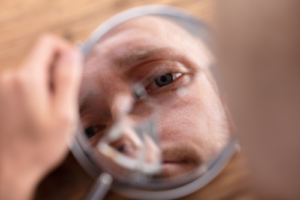Interpretive Biases and Body Dysmorphic Disorder


Written and verified by the psychologist Gorka Jiménez Pajares
Body dysmorphic disorder characterizes those who are deeply concerned about real or imagined defects in their physique. The defect may be barely noticeable to the people around them, but the discomfort they experience is extraordinary.
The concern of these individuals over their supposed defects is usually extremely intrusive, repetitive, limiting, and uncontrollable. It might involve any aspect, such as the shape, size, height, color, or asymmetry of areas of their body. This profoundly affects their life, often causing alterations in their social functioning.
“In general, the person tends to have more than one concern at the same time and the perceived physical defect or defects tend to vary over time.”
-Amparo Belloch-

Body dysmorphic disorder
The American Psychiatric Association (2014) states that sufferers of body dysmorphic disorder experience great concerns about at least one element they perceive as defective in their bodies. For example, acne, a scar, a sparsely muscled body, or a protruding nose. However, to outside observers, these defects are hardly noticeable. But, the sufferer reacts to their concerns with repetitive dysmorphic behaviors.
These may consist of often looking in mirrors in order to assess the appearance of the defect. Or, they may try to cover up the flaw with different clothes or makeup. On the other hand, they might give up and avoid contact with other people altogether. In fact, zero contact is one of the strategies often used by sufferers of this disorder.
Occasionally, the symptoms can reach such severity that the deterioration they cause is extremely significant from a clinical point of view. In these cases, they impact and deteriorate the personal, family, social, educational, and work areas.
“Isolation in these cases is common, although sometimes they also respond with anger and aggressive behavior.”
-Amparo Belloch-
Under the yoke of interpretation
Sufferers of body dysmorphic disorder exhibit alterations in their executive functions. More specifically, cognitive biases occur when they process and interpret information concerning their bodies.
Indeed, instead of codifying body information in an integrated manner, they process it in a way that focuses on imperfection. As a consequence, the interpretation they make of it is negative, which is threatening to them.
Some interpretive biases in body dysmorphic disorder
Other biases found in sufferers involve how they perceive themselves, how they interpret their perceptions, and how they believe they’re thought of.
- The sufferer tends to focus on minor details to the detriment of their whole body.
- On a neuropsychological level, they struggle to process faces and facial stimuli.
- They exhibit hyper-selective attention to everything that’s imperfect, regardless of whether the defect is in themselves or others. Moreover, they tend to compare themselves to other people with respect to specific flaws. For example: “That woman has smaller breasts than me doesn’t she?”.
- The way they process their emotional universe is biased. Thus, they interpret emotions transmitted through facial expressions in a negative way, even though, in reality, they’re neutral.
- They present a dysfunctional increase in self-awareness. As such, they’re excessively aware of their appearance. This makes them exaggerate the perception they have of their defects. Consequently, they build an unreal, distorted, altered, and disfigured image of themselves.
- They believe that the way they see themselves is how others see them. This potentially makes them excessively shy. They often observe themselves from an outsider’s perspective. For example, they might tell themselves “If I walk down the street with so much acne on my face, the people who walk by will think my face looks like a pizza”.
- The excessive importance they give to appearance impacts how they perceive that they’re accepted as an individual in society.
- They anticipate the future. They repeatedly rehearse different images of what might happen in their minds, with the aim of controlling and anticipating such events.
- Emotional disturbances occur. For instance, they might feel excessive shame about their shortcomings. This produces intensely negative emotions in the face of their failure to ‘be normal, like everyone else’, thus enhancing the interpretive biases described above.

There are a multitude of interpretative biases that favor and maintain the development of this disorder. The sufferer lacks the ability to integrate the small defect into their body. So, they magnify it and it occupies their entire mental sphere. In fact, the defect takes over. Fortunately, there are effective treatments available, such as cognitive behavioral therapy.
“Interpretive type biases refer to the presence of very high standards of the importance of physical appearance, beauty, and perfection over appearance.”
-Amparo Belloch-
All cited sources were thoroughly reviewed by our team to ensure their quality, reliability, currency, and validity. The bibliography of this article was considered reliable and of academic or scientific accuracy.
-
De Sanidad, C. y B. S., & España Ministerio de Sanidad, C. y B. S. (2020). CIE-10-ES: Clasificación internacional de enfermedades : 10a revisión modificación clínica. Ministerio de Sanidad, Consumo y Bienestar Social.
-
American Psychiatric Association. (2014). DSM-5. Guía de consulta de los criterios diagnósticos del DSM-5: DSM-5®. Spanish Edition of the Desk Reference to the Diagnostic Criteria From DSM-5® (1.a ed.). Editorial Médica Panamericana.
-
Belloch, A. (2023). Manual de psicopatología, vol II.
-
Carrobles, J. A. S. (2014). Manual de psicopatología y trastornos psicológicos (2a). Ediciones Pirámide.
-
Salaberría, K., Borda Más, M., Amor Andrés, P. J., & Echeburúa Odriozola, E. (2000). Tratamiento del trastorno dismórfico corporal: una revisión crítica.
- http://scielo.sld.cu/scielo.php?pid=S1029-30432014000300011&script=sci_arttext&tlng=pt
This text is provided for informational purposes only and does not replace consultation with a professional. If in doubt, consult your specialist.








